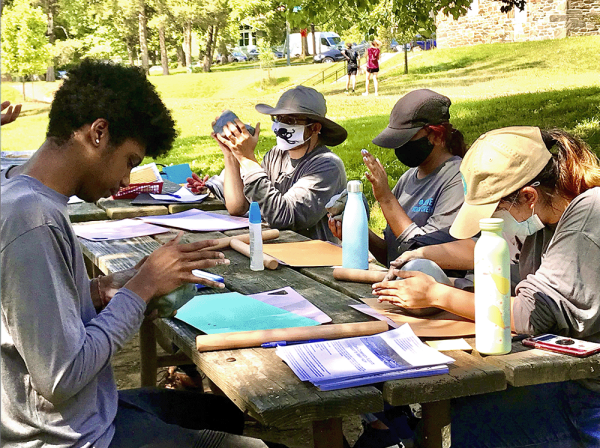Eco-Equity Grant Recipients 2020-21
Jordana Rubenstein-Edberg
Jordana Rubenstein-Edberg is a multi-disciplinary artist focused on creating spaces for community dialogue. She is primarily interested in how collaborative art practices foster cross-cultural connection, act as political commentary, and facilitate healing. The majority of Jordana’s pieces take place out of the traditional artistic settings; in buses, parks and fields, and utilize interviews and historical events as a basis for creation. A Washington, D.C., native, Jordana grew up in a theater of the oppressed based program at the Atlas Performing Arts Center. It was here where she began to understand the power of storytelling to shift perceptions, build relationships, and create unity from fragmentation.
(Un)Natural Divides:
(Un)Natural Divides is an "eco-art" project that brings together environmental education, artistic practice, and activism to address the presence of Rock Creek Park in Washington DC. (Un)Natural Divides seeks to change how this public space is utilized and represented. As an important natural space that runs through the city, the park is a beautiful space, as well as a marker of the segregation that exists within our city. The park geographically divides the eastern and western parts of the city, which are then further divided by the western part of the city's increased access to healthcare, food, and equitable education, and the eastern part of the cities decreased access to these crucial resources. This summer, we collaborated with Rock Creek Conservancy (RCC) and it's summer youth program to explore and recreate what safety and belonging mean in the public space of this park.
As part of our summer collaboration, I co-created a curriculum that explored the experiential side of many conservation issues that students learn about in the RCC summer program. For example, when we talk about the urban heat island effect, how does this impact us on a daily basis and personal level? When we think about the fact that Rock Creek park divides Washington DC on a geographic and resource level, what does this really mean? How do we see this difference in access to things like school funding or grocery stores impacting our communities? In addition to sharing about our personal experiences with Rock Creek Park, as well as public spaces in our communities, students created ceramic tiles with engraved images and poems that represent their visions for safety and belonging in their city and within public green spaces. Students transformed our writings and discussions into a manifesto on Safety Inclusivity, and Belonging for the future of Rock Creek Park. In this manifesto, they identified what it would look like for the park to be a truly inclusive space. Students shared their art work and writing at their self-titled "EARTH Gallery" at the Reservation 630, which is a site currently in the process of being renamed due to its connection with a controversial public figure who participated in the segregation of DC. Members of the Rock Creek Conservancy and the Rock Creek Park staff were invited to view the students artwork as well as read the Manifesto on Safety and Belonging that students created.
Ruth Dickey-Chasins
Ruth Dickey-Chasins is a second-year MPH student in the Global Environmental Health program. She is also the Vice President of the Environmental Justice Action Network (EJAN), a student activist group. She is passionate about climate justice and sustainability, and hopes to incorporate this into her future public health career.
Ward 8 Waterways
GW's Environmental Justice Action Network (EJAN) has partnered with community organization Ward 8 Woods to conduct stream sampling and monitoring across Ward 8. The project, entitled "Ward 8 Waterways," is funded thanks to the GW Upstart Eco-Equity Grant. Students have been taking monthly samples from previously neglected streams identified through Ward 8 Woods’ pilot project, and will continue their monthly sampling throughout the fall. The sites selected for this project include two streams off the Suitland Parkway -St. Elizabeth’s Tributary and the 23rd street stream -as well as Magnolia Tributary at Oxon Run Parkway and the Erie Street Tributary at Fort Stanton Park. Data is being gathered on variables including temperature, turbidity, pH, and bacteria. Preliminary results have already revealed elevated concentrations of dangerous pathogens at several of the sites. These results may be due to sewage leakage or extremely dry conditions that exacerbate bacterial growth. The students willreturn to these four sites for the next six months and monitor changes in collaboration with Ward 8 Woods to target remediation for the streams so that they can eventually be publicly accessible by Ward 8 residents.




